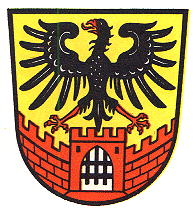Sinzig: Difference between revisions
Jump to navigation
Jump to search
Knorrepoes (talk | contribs) m (Text replacement - "{{de}}" to "") |
Knorrepoes (talk | contribs) m (Text replacement - "{| class="wikitable"↵|+Official blazon↵|-↵|'''German'''↵| ↵|-↵|'''English''' ↵| {{blazon wanted}}↵|}" to "{| class="wikitable" |+Official blazon |- |'''German''' | blazon wanted |- |'''English''' | blazon wanted |}") |
||
| Line 13: | Line 13: | ||
|- | |- | ||
|'''German''' | |'''German''' | ||
| | | blazon wanted | ||
|- | |- | ||
|'''English''' | |'''English''' | ||
| | | blazon wanted | ||
|} | |} | ||
Revision as of 08:08, 6 April 2023
SINZIG
State : Rheinland-Pfalz
District (Kreis) : Ahrweiler
Additions : 1969 Bodendorf, Franken, Koisdorf, Löhndorf, Westum
| German | blazon wanted |
| English | blazon wanted |
Origin/meaning
During the middle ages a royal palace was situated near Sinzig. Sinzig received city rights in the early 13th century and the oldest known seal dates from the first half of the 13th century. The seal shows a King sitting on a throne, all placed above a city wall. From the 14th century onwards, the imperial eagle replaced the king. In the late 15th century the city wall disappears and until the 19th century all seals showed only the eagle.
In the mid 19th century the above arms were devised, based on the 14th and 15th century seals of the city.
| The arms by Hupp in the Kaffee Hag albums +/- 1925 |
Postal cancellation 1939 |
Literature: Stadler, 1964-1971, 8 volumes.


